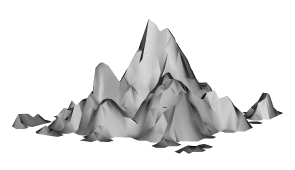Biological Weathering
Plants and animals are also responsible for breaking
up rocks. Soil can gather
in the cracks of rocks and if seeds land
there, plants can grow. The roots of the plants push their way through the cracks of rocks and as the roots grow
they gradually push the rocks apart.
See animation opposite. Burrowing
animals and humans also wear away rocks as they dig.
Biological
weathering - caused
by plants and animals
Erosion And Transport
Erosion is different from weathering, as it is the wearing away of exposed rocks by other moving rocks, via any means. The weathered rocks (pieces of broken rocks) are often found a long distance from the original rocks. These rocks come in different shapes and sizes. The transportation of these rocks can happen in four different ways.
GravityThe windRivers and seas - moving waterGlaciers - moving ice |
 |
Gravity: The gravitational pull of the Earth can move any shape or size of rocks. It moves the rock to the lowest point on the land. From here on, other forces can move the rock further still, from it original place.
Wind: It can only carry small grains, like sand in desert storms. Continuous bombardment, over thousands of years, by these small grains can erode away rocks, particularly softer ones.
Rivers: The speed of the flowing water determines which fragment is moved. Rivers usually flow quickly near their origin in the mountains. They slowdown as they approach the sea. Fast moving water in rivers can move small rocks and stones along the bottom. These moving rocks and stones carve out V-shaped valleys in the eroded land. Slow moving water can only carry small particles along, for example sand and other sediments.
Seas: Costal erosion is predominantly caused by the sea. The force of the sea waves, mixed with stones and pebbles 'chip' away against the coastline. Cliffs can be eroded above and below the water levels. The rounded rocks you encounter on the pebbly beaches are the result of constant bashing and rubbing of rocks against each other as waves, currents and tides move them backwards, forwards and along the beach.
Glaciers: These ice river are very slow moving, about a meter per day. Nevertheless, they are more effective at eroding rocks, which they pass over, than rivers. This is due to the ability of glaciers being able to carry along rocks of all sizes. They can even pull along large boulders. These scrape away the rock along the bottom of the glacier. This results in the formation of U-shaped valleys.
What Happens to eroded rock?
The pieces of rock that have been weathered or eroded eventually settle else where. The smaller fragments form the basis of soils. These tiny pieces are usually deposited by slow moving rivers near the sea. Even the fine grains of rock settle to the bottom of the river. These deposited bits are called Sediments.
When rivers change course or run dry, they leave the sediments behind, forming fertile soil. The type and quality of soil formed naturally depends on the kind of rock the river has journeyed over. These sediments are the basis of all sedimentary rocks. See rocks.
Tags:Erosion, Transport, Weathering, Biological weathering, How do weathering and erosion work together, what does weathering mean, chemical weathering acid rain